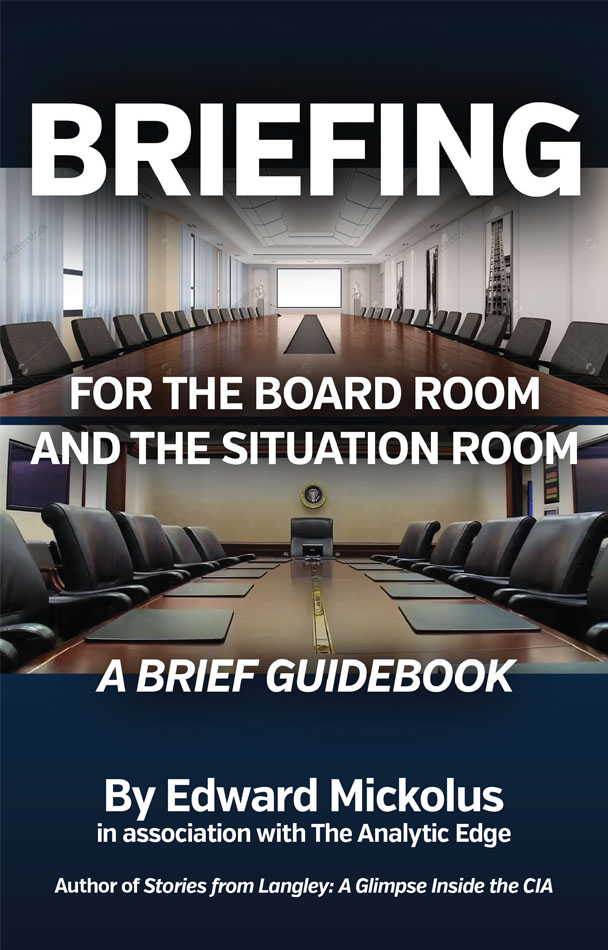Briefing—a specialized form of public speaking tailored to a powerful audience, such as presidents, CEOs, and generals—requires developing a specific use of skills. In Briefing for the Board Room and the Situation Room, novice and seasoned briefers will explore such issues as:
• How do you get past your nervousness?
• How do you determine the needs of an audience?
• How does the environment affect the likelihood of an effective briefing?
• How do you organize a briefing and otherwise prepare it?
• What makes for an effective handout, graphic, talking point, and visual?
• How should you answer questions?
• How does your personal speaking style affect your effectiveness?
• What should you do after the briefing is over?
This guidebook gives you clear, straightforward tips and techniques to make you a confident, effective briefer who will be invited back by your audiences.
Praise for the book:
“I loved the book and wish I had it 40 years ago! Very comprehensive and while somewhat slanted towards intelligence briefings (no surprise there), I think it provides valuable information for any setting. It was informative and a pleasure to read. Loved the mnemonic SUCCESS. “Know your audience” is so critical.”
—Robert M. Heffernan, Lt.Col., USAF (Retired), former Command Briefing Officer, HQ 13th AF, who briefed General Norman Schwarzkopf
“Where was this book when I was a young, introverted CIA analyst stumbling over my words? It took me many painful years to learn all of the things covered so well here by Ed Mickolus-from strategies for handling nerves to follow-up after the briefing. Skill at briefing can put your career on the fast track. Lack of skill can sink it even faster. This book is a must-read for anyone who must face a conference table full of VIPs. It will even tell you why your hands are sweating.”
—Susan Hasler, former speechwriter for three Directors of Central Intelligence and author of Intelligence, Project Half Sheep, and The Flat Bureaucrat
“Dr. Mickolus is a sure-footed guide to the techniques for effective oral presentations and careful study of this book will repay the reader many times over.”
—Dr. Michael D. Smith quondam briefer of The President’s Daily Brief
“Dr. Mickolus has written a very insightful how-to on briefing, one of the most important communication skills for anyone to acquire. Comprehensive yet concise, the book covers every aspect of briefing, including how to manage briefings by a team. Briefers at every level will find something useful here.”-– former director of public affairs
“Written by a real expert. Thoughtful, insightful, elegantly brief and even fun to read.”–Philip Stern
- Title : Briefing for the Board Room and the Situation Room: A Brief Guidebook
- Author : Edward Mickolus with Analytic Edge
- Publisher : Wandering Woods Publishers
- Publication Date : December 2, 2015
- Language : English
- Paperback : 82 pages
- ISBN-10 : 1949173089
- ISBN-13 : 978-1949173086
- Item Weight : 3.21 ounces
- Dimensions : 5 x 0.19 x 8 inches

Table of Contents
- Introduction
- Nervousness
- Know your audience
- Know your environment
- Organizing a briefing
- Graphics
- How to Answer Questions
- Speaking Styles and Habits: Delivery
- Group Briefings
- Follow-up
- Practice Exercise
- Bibliography
- Videos
- About the Author
Introduction
Whatever your job, from attorney to intelligence officer, from doctor to financial analyst, and anything in between, at some point, you’re going to be called upon to brief someone, whether it be your boss, colleagues, peers outside your organization, or someone outside your food chain but interested in your topic. This may require you to talk to someone one-on-one, to a large group in an auditorium, to a group via a video conference, or in hundreds of other scenarios.
This book is intended to give you the tools you need to succeed in briefing situations. We’ll look at channeling your nervous energy, how to research an audience and the briefing environment ahead of time, how to organize the briefing and pepper it with effective graphics, how to answer questions, and how to put your individual speaking talents to their best use.
It’s important to keep in mind that briefing is only a subset of general public speaking. Briefing is designed to convey information, often in what appears to be an informal, conversational setting, and often in a more structured setting. It does not include other forms of public speaking, be it delivering eulogies, performing standup comedy, or a plethora of other types of speaking. Some of the techniques relevant to briefing can be used in those scenarios, but for our purposes, we’ll limit our discussion to informational briefings.
Briefing has its own unique requirements. It is a very specific subset of public speaking. Many of the audiences I’ve dealt with say that they find briefings preferable to written products. They’ve told me that in briefings:
- They can ask you questions.
- They can bounce ideas off you.
- They can get clarifications.
- They want to offer their views to you.
- They want to offer their praise and suggest ways they can support you.
- They want to give you additional tasking.
- They don’t have time to read your paper but want the key points.
Despite your reservations about your skills, I know that you can succeed as a briefer. Consider when you introduce yourself to someone. You quickly summarize material that you’ve collected about yourself over the years, pick out the most important points, and present it in a well-organized, interesting presentation. That’s all that briefing entails!
A Note on Terminology
Briefing: An information presentation, usually oral, sometimes festooned with handouts, slides, graphics, and other materials.
Principal: The senior-most individual who initially requested your presentation. Usually the most senior-ranking person in the room, but can sometimes be outranked by walk-ins who heard about your briefing.
Moat Monster: A gatekeeper for the principal, usually a special assistant (formerly known as a secretary, although special assistants do so much more in business and government), aide de camp, or executive assistant.
Minions: A great movie, but also refers to various aides to the principal. They can be equal to the principal in rank, or even senior to the principal if invited in after the principal secured the briefer’s services.
Sample Chapter
Know Your Environment
In this chapter, we will explore how to prepare for what might go wrong given the environment in which we’ll be briefing, develop a toolbox with all sorts of Plan B ideas, and help you build confidence in knowing that you can handle unexpected reverses.
A key source of nervousness is our uneasy feeling that something can go wrong—we’re not sure what—and that we won’t be prepared and look foolish. Here are a few things that have gone wrong in my and my friends’ briefings that didn’t have to do with the substance of the briefing or the audience. Stated differently: “I wish I’d known ahead of time…”
- Gestured too broadly, hit the principal’s coffee cup, doused him with scalding hot coffee. Do you then help clean up their laps?
- Audiovisual system and/or computer didn’t work; host’s systems incompatible with our DVDs/CDs; no/spotty Internet connection
- Slides/DVD didn’t arrive
- Handouts didn’t arrive
- Trapped in restroom when door handle fell off
- Elevator jams, trapping briefer
- Many more people in the room than expected; didn’t have enough handouts
- Had to stand very far away from the principal, who was the only person in the room with briefer
- Weather/car splatter ruined briefer’s attire
- Rain/snow/sleet damaged handouts/technical equipment for briefing
- Last-minute demand for briefer, who had dressed for Casual Day; no time to go home to change
- Security officers refused to allow briefers to take tech equipment into building
- Microphone too loud/soft/staticy/nonexistent
- Loud drilling/other construction noise nearby
- Not enough paper for the flip chart
- No markers for the flip chart
- Laser pointer’s batteries died
- Unknown people walking in and out during briefing
- Birds/animals entering/leaving briefing room
- Sun in briefer’s eyes
- Chair/table broke during briefing (my favorite—three briefing team members leaned back too far on a couch, tipping it backwards, spilling them)
How can you protect yourself? Here’s a simple truism that briefers too often forget: briefings occur somewhere, and those “somewheres” are unique. Those “somewheres” present unique challenges, some of which we cannot control, but many of which we can, if we act ahead of time. Sometimes we’re on our turf, sometimes the principal’s, sometimes on a neutral court.
What can you do ahead of time to prevent disaster?
If you can, get into the briefing room beforehand—ideally, before the day of the briefing as well as an hour before the briefing—and use the above litany as a checklist. Among the considerations:
- sightlines Will the sun be in your eyes? Can you see the audience so that you can call on them if they have a question? Can they see you? Are there obstructed views?
- sound—not just “Is there a microphone?” but “how do I quickly find A/V staff onsite if things go wrong?” Check the acoustics of the room. Can they hear you? Will you be able to hear their questions?
- Are there any security requirements that limit your flexibility? How much time does the security staff need to check out your equipment, and you? If you’re in a classified environment, have your clearances arrived ahead of time? If you’re hosting the briefing, has your security staff received the clearances of the audience members?
- Do you need to pass credentials ahead of time?
- Is the A/V equipment compatible with your computer/PDA?
- What language will the briefing be in? Meet with the translator ahead of time and explain uncommon technical terms.
- What’s the dress code? Don’t just mimic their putative style. What do they expect from someone from your organization briefing someone from their organization?
- What’s the organizational culture regarding briefings? Do they demand slides? Just because your organization doesn’t do PowerPoint doesn’t mean that military officers will be comfortable sans slides. Sales staff might need charts and graphs.
- Where are you supposed to sit? In some organizational cultures, the principal sits in the middle of the table, rather than at the end. Make sure that you know your place, literally.
- What’s the principal look like? Find a photo. You want to make sure that you’re addressing the right person. A colleague once began addressing the best-dressed person in the room, only to be stopped and introduced to the scruffier, but more powerful, principal.
- Are you using a tablet? Only, or with other materials? With a projector? Are you going to hand it to the principal? How are you going to ensure that what you want to be clicked, gets clicked? Are there security concerns about tablets in the room? Is there glare?
After you’ve considered all of these items, go back to the original horror stories and ask yourself how your pre-briefing preparation can assist you in avoiding, or at least mitigating, these mishaps.
This will give you some feeling for what you should consider before you walk into a briefing. Other things can happen but at least you know that you can still get through surprises by being flexible and being willing to switch to Plan B seamlessly. Briefing is all about thinking on your feet, even if you’re sitting.







